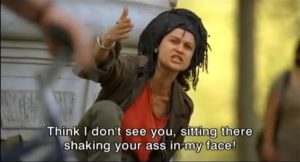by Marylyn Tan, Change Maker
What happens when the patriarchy is turned on its head? Watched the French film, Majorité Opprimée (Oppressed Majority), and you’ll get a glimpse of it. The ten-minute film went viral earlier this year, despite having come out a few years before—perhaps because feminist issues are becoming ever more relevant, especially in Europe, where abortion rights and laws regarding homosexuality have ‘taken a turn for the worse’, according to the film’s creator, Eleonore Pourriat. Majorité Opprimée may have inspired the recent slew—good or bad—of gender role reversals in the media, such as that horrendously sexist Veet advertising campaign which exhorts women not to ‘risk dudeness’.
More encouragingly, however, the role-reversal trend has also been used to illustrate the problems with the way women are portrayed in audio-visual media—such as in the photoset, ‘seDUCATIve vs. MANigale’, in which one motorcycle company parodies another’s traditional ‘model in sexually-provocative poses with equally attractive vehicle’ ad campaign by replacing the women with men. Even Jennifer Lopez’s latest single, I Luh Ya Papi, explicitly lashes out against exploitative differences in marketing male and female artistes in the music industry. What I find so powerful about Majorité Opprimée, however, is the incisive, stark fashion in which little everyday instances of gender violence are depicted.
The film isn’t meant to be wholly realistic—most films aren’t—but it does set its sights on portraying a wide slew of behaviours (all within ten minutes!) that both men and women engage in that foster a narrative of violence in everyday interactions. Unknowingly, unconsciously, we have all probably been party to reinforcing sexist attitudes at some point. The film is set in an unnamed French town where it is almost immediately—though subtly—established that the women are in charge. This is a vision of a matriarchal society, and our protagonist, Pierre, illustrates this most starkly in his interactions with the women of his everyday life. Again, it’s the microaggressions in a sexist society that the film highlights, such as being stared at on the streets in unison by a trio of women, and unprovoked—unwanted—comments on one’s appearance such as ‘how lucky you are to have such a cute daddy!’
The assertion of matriarchy is even more subtle when the women aren’t actually interacting with the protagonist. An implied balance of power is shown by issues ingrained far more deeply into this society, such as women jogging bare-chested in public, a wife’s control and restriction over what her husband can wear or must cover up, and how most, if not all, positions in authority are depicted as being held by females. In Majorité Opprimée, the men make the coffee, have to be picked up by their wives, and are told that their ‘outfits are cute’ on them. In this hypothetical matriarchy, the men have their social status constantly, and casually, belittled, such as when the protagonist’s landlady smiles dismissively and says, ‘I should really be talking to your wife.’
Majorité Opprimée, illustrates the vast range of aggressions directed at women on a daily basis (most of which aren’t even recognised as violence, but as an accepted gender dynamic). Pierre, then, might represent women as a whole, who are every day catcalled, dismissed, and assaulted all over the world. One of the film’s strongest points is its illustration of street harassment, an issue which repeatedly surfaces in today’s discussions of gender violence. To anyone who’s ever experienced any form of harassment in public—and, hopefully, to some who have not—the scenarios painted are all too real. Often, women are told that it’s not such a big deal, and even that it’s to be expected. After all, how debilitating can a single whistle by the roadside be? One catcalling comment on your appearance? A honk as a driver speeds by? These are, unfortunately, seen as unpleasant, but normal, by some people. As one of the women in the film threatens to give chase as Pierre hastens away from a junction where she’s been catcalling him, the fear for one’s own safety caused by ‘expected’ interactions is apparent. It is, to say the least, quite intolerable when one faces aggression and fear as a regular feature of daily life.
What makes Majorité Opprimée so important is the fact that violence is everywhere in popular culture, and everyday social interactions, and in various insidious ways that people who don’t usually experience it have a hard time understanding. The film takes these instances of violence and forces us to re-evaluate our understanding of what we consider ‘normal’ behaviour. Watch it. Make the people around you watch it. Perhaps some the manifold violences written into the scripts of our everyday lives will stop going unnoticed.

